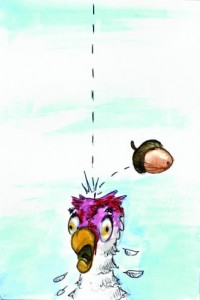 It’s December and the word “story” might create subconscious associations with certain themes, namely, A Christmas Story, The Nutcracker, The Night Before Christmas and other holiday plays. If you are looking for an escape from the expensive, glitzy, glittery, orchestral pieces of theater so well represented this time a year, you will find reprieve at Second Story Theatre’s production of Story Theater.
It’s December and the word “story” might create subconscious associations with certain themes, namely, A Christmas Story, The Nutcracker, The Night Before Christmas and other holiday plays. If you are looking for an escape from the expensive, glitzy, glittery, orchestral pieces of theater so well represented this time a year, you will find reprieve at Second Story Theatre’s production of Story Theater.
Story Theater is a musical play written by Paul Sills and performed on Broadway between 1970-71. It is a medley of Brother’s Grimms’ and Aesops’ fairytales narrated by a small cast of eight actors, who dot the narration with songs performed live by two of the actors. In the Broadway play, a folk-rock band played covers by Bob Dylan, George Harrison and other contemporary musicians. In the Second Story version, directed by Erin Olson, the music is performed by the local folk music husband-and-wife-duo Aubrey Atwater and Elwood Donnelly, who sing their originals accompanied by guitar and dulcimer. If you are a fan of Atwater – Donnelly you will find this play enjoyable for the music itself: It is performed beautifully in a fitting environment, and the subject-matter of the songs align well with the folksy tales. Indeed, these offer some escape from the at times exaggerated exuberance of the narrators; an undefined itinerant troupe of some sort.
The set, which remains the same throughout with some surprise additions, is reminiscent of your land-owning-hippie-friends backyard: tiny house, wood barrels, outdoor seating, sky-lit night. It effectively communicates some sort of nomadic lifestyle that is hinted at by the nature of the tattered clothing, outdoor accommodations and that slamming-looking wooden covered cart (aka tiny house) that serves the stories well as imagined cottage, castle and fox-den. The set is lovely and is complemented with shadow puppetry, lighting effects and off-stage sound effects. It speaks to the company’s maturity and creatively produces a belief in transcending landscapes and scenarios that extend beyond the audience’s view.
The play starts with a sleepy scene sung to the audience and interrupted by one troupe-member’s inability to reach REM. At his announcing this fact, his fellow travelers delve into story time with zealous accommodation. Debaucherous and rowdy, the stories eventually (somehow) lead to communal relaxation and a return to sleep and a closing song.
Indeed, it is what happens between the songs that requires you to utilize some of your holiday spirit, both to indulge in the Grimm stories meant to entertain little ones (some of them are very funny, others miss the mark a bit) and to swallow the heavy use of improvisation in the play. Sill’s mother, Viola Spolin, spearheaded the introduction of improvisational theater in America, and Story Theater uses the techniques generally referred to as improv theater.
It is unclear how much of the play is improvised and how much of it is scripted, which makes it a bit confusing. Walking in cold to this insight, the play felt at times exaggerated, loud and silly; the typical aftertaste of un-vulgar, un-revolutionary, and un-sarcastic improv. We have to give credit to the actors for walking the fine line of using the genre that is best used for frank and raunchy commentary about the darker, dirtier sides of human experience (a rough generalization of improv) to entertain an audience with children’s stories. From my seat I at times wondered if I the play was meant for me, for my nieces, or for the Atwater-Donnolly fan-base.
Despite these concerns there were some definite highlights; the use of cross-dressing added some endearing qualities to the fisherman’s wife (played by Steven Dionne; beard and all) and to Nicole Maynard’s incredible performance in all her roles. Staying mainly in female roles Valerie Westgate is likable as a chatty squirrel, a confident fox and a slutty wife caught with a pastor. It isn’t hard to imagine these actors acing other types of theater and/or even simply having a better night improvising. Max Ponticelli’s lighting and production design is beautifully executed, and the contributions of stomping feet, ham-bones, singing and other accompaniment during the music performances makes the production jovial. It is a distinct move away from the glamming glitter of other Christmas plays, but it’s in our backyard, the music rocks and it’s sure to leave you a little warmer and fuzzier inside then when you got there.



